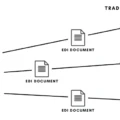IPsec is a group of protocols that provide secure communication over the Internet. It is commonly used to set up virtual private networks (VPNs), and it helps keep data sent over public networks secure. IPsec uses encryption and authentication to protect data on the Internet, and it works by encrypting IP packets and authenticating the source where the packets come from.
IPsec works at the network layer of the Internet Protocol (IP) stack, providing end-to-end encryption. This means that data is encrypted at its source before being sent out over a public network, so any intermediate systems handling the encrypted portion of the packets will only see them as payload. This provides an additional layer of security for sensitive information as it travels between two or more locations over an insecure network.
The principal protocols used in IPsec are Authentication Header (AH), Encapsulating Security Payload (ESP), and AH/ESP combined. AH provides authentication, integrity, and replay protection for IP datagrams, while ESP provides confidentiality and authentication for IP datagrams. Both AH and ESP can be used together or separately depending on particular needs, such as when using IPSec for VPNs or for protecting data stored in cloud services.
When it comes to encryption algorithms, AES (Advanced Encryption Standard) is currently considered to be the strongest available option with its ability to encrypt data with a 256-bit key size. AES is used in many different areas – from software applications to hardware devices – due to its high level of security and speed performance.
IPsec offers an effective way to protect sensitive information while it travels across public networks. By combining strong encryption algorithms with authentication protocols such as AH and ESP, organizations can ensure that their confidential data remains secure throughout its journey from one location to another.
The Basics of IPsec Encryption
IPsec encryption is a set of protocols used to secure communication over public networks, such as the Internet. It works by encrypting IP packets, verifying the source of the packets, and authenticating both ends of the connection. IPsec encryption provides an additional layer of security that helps protect data from being intercepted or modified while in transit between two endpoints. It can be used to create Virtual Private Networks (VPNs) that allow users to securely access remote networks. Additionally, IPsec can be used to provide site-to-site connections between different locations, allowing organizations to keep their networks secure even when they span multiple locations.

Protocols Used in IPsec
The three protocols used in IPsec are Authentication Header (AH), Encapsulating Security Payload (ESP), and AH and ESP combined.
Authentication Header (AH) is a protocol that provides data origin authentication, data integrity, and replay protection. It ensures that the packet was not tampered with during transit by using a cryptographic authentication key to authenticate the packet’s source and integrity. AH also prevents replay attacks by generating a unique sequence number for each packet transmitted.
Encapsulating Security Payload (ESP) is another protocol used in IPsec which provides confidentiality, data origin authentication, data integrity, anti-replay services, and optional limited traffic flow confidentiality. ESP uses encryption algorithms such as AES or Triple DES to encrypt the data payload of an IP packet, ensuring the privacy of the transmitted information.
The third protocol used in IPsec is AH and ESP combined. This combination allows both AH and ESP to function together and provide enhanced security services such as message integrity and encryption for an IP packet. This combination also provides anti-replay services which help protect against malicious attackers attempting to resend valid packets from being successful.
The End-to-End Encryption Capabilities of IPsec
Yes, IPsec is an end-to-end encryption protocol. It provides encryption and authentication for data packets sent over a network, ensuring that only the intended recipient can access the contents. IPsec can be used to encrypt data between two computers or between multiple nodes in a network. It works by establishing a secure tunnel between the two endpoints and then encrypting all data that passes through it. The encrypted data is then decrypted by the recipient at the other end of the tunnel. This ensures that any data intercepted during transit will be unintelligible to anyone who does not have access to the same encryption keys used for encryption.
The Best Encryption for IPsec
IPSec (IP Security) is an internet protocol suite designed to secure communications at the IP layer, and it employs a variety of encryption protocols. The most commonly used encryption for IPSec is Advanced Encryption Standard (AES). AES is an advanced symmetric-key algorithm that provides strong encryption, and it can use 128-bit, 192-bit, or 256-bit keys. It’s fast and secure, making it an ideal choice for IPSec. Other encryption options include Triple DES (3DES), which is slower but still considered secure; Blowfish, which provides good security but is not as widely used; RC4, which is fast but less secure; and Null encryption, which does not provide any security at all. AES is generally considered the best choice for IPSec due to its robustness and wide acceptance.
Comparing IPsec and VPN: Which is Better?
IPsec is a protocol suite that provides secure communications over IP networks. It is often used as part of Virtual Private Networks (VPNs) and can be used to provide network security, data integrity, and authentication. IPsec provides encryption and authentication between two endpoints, which allows for secure communication between the endpoints.
Whether IPsec is better than VPN depends on the use case. For site-to-site VPNs, IPsec is typically preferred due to its ability to provide strong encryption and authentication between two endpoints. For remote access VPNs, SSL may be preferable due to its ease of setup and use.
In general, both protocols have their advantages and disadvantages depending on the situation. Ultimately, the best option for a given situation will depend on the specific requirements of that situation.
Example of IPsec
An example of IPsec is a Virtual Private Network (VPN) connection between two remote sites. This connection is used to securely connect two networks over the public Internet by encrypting all traffic passing between them. The encryption is provided by the IPsec protocol, which provides data integrity, confidentiality, and authenticity of the data being exchanged. This ensures that only authorized users can access the network and that all data sent over the connection remains private and secure.
Step-by-Step Explanation of How IPsec Works
IPsec is a security protocol that works by encrypting data packets sent between two or more computers over an Internet Protocol network. It provides authentication and encryption services to ensure privacy and integrity of data communication. Here is a step-by-step guide on how IPsec works:
Step 1: Defining Interesting Traffic – This is the first step in the IPsec process. The security policy configured in the IPsec peers must first define what kind of traffic will be considered “interesting”. This could include web traffic, emails, file transfers, etc. This information is then used to determine which packets will be encrypted during transmission.
Step 2: IKE Phase One – In this phase, the two endpoints negotiate security parameters such as encryption algorithms and authentication methods. A secure connection is established between the two peers using the Internet Key Exchange (IKE) protocol.
Step 3: IKE Phase Two – After the successful negotiation of security parameters in phase one, an authenticated key exchange takes place in this phase. As part of this process, a shared secret key is generated and used for further encryption/decryption operations.
Step 4: IPSec Encrypted Tunnel – Once all the above steps are completed successfully, an encrypted tunnel is established between the two endpoints. All data packets sent over this tunnel are encrypted using negotiated security parameters from earlier stages such as encryption algorithms, authentication methods, etc.
Step 5: Tunnel Termination– When either side decides to terminate the secure connection due to any reason such as timeout or user action, both sides must agree on session termination procedures before disconnecting from each other’s network.
Comparing the Security of IPsec and SSL
IPsec and SSL are both secure protocols that can be used to encrypt data sent over the internet. They both provide a high level of security and encryption, so the choice between them usually comes down to what type of access you need.
IPsec is generally considered more secure than SSL because it encrypts the entire communication session, including headers, payloads, and acknowledgments. It also uses stronger key exchange algorithms than SSL, making it harder to crack. IPsec can be used to connect two networks together or to provide remote access for individual users, but it requires more configuration and is more complicated to set up than SSL.
SSL only encrypts the data portion of a communication session, which makes it simpler and faster to set up than IPsec. However, this also means that extra care must be taken when configuring SSL connections as they can be vulnerable if not properly secured. For example, if an attacker were able to intercept and modify data in transit, they could potentially gain access to sensitive information without being detected.
Ultimately, when choosing between IPsec and SSL for your network security needs, you need to consider your specific requirements and determine which protocol best fits your needs. If you need high-level encryption for connecting two networks together or providing remote access for individual users then IPsec may be the better choice; however, if you need a simpler setup with lighter encryption then SSL may be a better choice.
The Security of IPsec
Yes, IPsec is an extremely secure method of data transmission. It encrypts data in transit using powerful algorithms that are virtually impossible to break without the correct encryption key. Additionally, it can provide authentication and integrity checks to ensure that no unauthorized changes occur while data is in transit. It also uses mutual authentication so both parties can be sure they are communicating with the expected recipient. As a result, IPsec is a highly secure way to transmit sensitive information over public or private networks.
Is IPsec Still Relevant in Modern Network Security?
No, IPsec is not outdated. It is still a widely used protocol for providing secure communication over the internet. While it does not have encryption services, it does provide origin authentication, data integrity, and replay protection services. Additionally, IPsec is highly versatile and can be used in various scenarios such as tunnel mode or transport mode. Furthermore, it is supported by many different operating systems and devices making it a popular choice for many organizations.
The Benefits of Using IPsec
IPsec is an Internet Protocol (IP) security protocol suite used to protect communications across an IP network. It provides authentication, encryption, and data integrity services to ensure that secure communication is maintained between two systems. IPsec is used to protect data from interception, modification, or repudiation by malicious actors. It does this by using cryptographic algorithms and keys that are shared between the two communicating systems. The cryptographic algorithms and keys used in IPsec can be configured for a wide range of security policies, making it highly flexible for different environments and requirements. Additionally, IPsec can be used for both site-to-site and remote access VPNs, making it a good choice for organizations that need a secure connection over public networks. It also helps organizations meet compliance requirements such as HIPAA or PCI DSS.
Conclusion
In conclusion, IPSec is a group of protocols that provides secure transmission of data over public networks. It works by encrypting IP packets, authenticating the source where the packets come from, and providing data origin authentication, data integrity, and replay protection. IPSec operates at the network layer to provide end-to-end encryption using AES (Advanced Encryption Standard), which is currently the strongest encryption algorithm available. With the help of IPSec, organizations can rest assured that their data remains safe and secure when transmitted over public networks.








